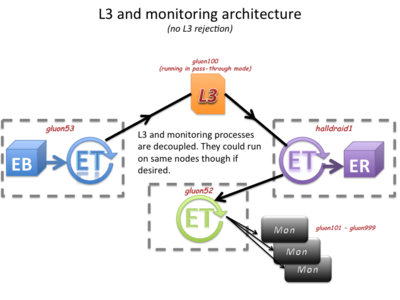Difference between revisions of "Online Monitoring Shift"
(Created page with "== The Online Monitoring System == The Online Monitoring System is a software system that couples with the Data Acquisition System to monitor the quality of the data as it is...") |
|||
| Line 1: | Line 1: | ||
== The Online Monitoring System == | == The Online Monitoring System == | ||
| + | |||
| + | [[Image:20140528_L3MonitoringArchitecture.png| thumb | 400px | Fig. 2. Online Monitoring and L3 Architecture when a Level-3 trigger is active.]] | ||
| + | |||
| + | [[Image:20140528_L3MonitoringArchitecture_noL3.png| thumb | 400px | Fig. 2. Online Monitoring Architecture when a Level-3 trigger is inactive. A single "L3" process will still be present and operating in pass-through mode. Note that monitoring is done on the "post-L3" stream to allow the algorithm to set flags in the data stream indicating that pass-through mode was used.]] | ||
| + | |||
The Online Monitoring System is a software system that couples with the Data Acquisition System to monitor the quality of the data as it is read in. The system is responsible for ensuring that the detector systems are producing data of sufficient quality that successful analysis of the data in the offline capable of producing a physics result is likely. | The Online Monitoring System is a software system that couples with the Data Acquisition System to monitor the quality of the data as it is read in. The system is responsible for ensuring that the detector systems are producing data of sufficient quality that successful analysis of the data in the offline capable of producing a physics result is likely. | ||
| + | |||
| + | Events will be transported across the network via the ET (Event Transfer) system developed and used as part of the DAQ architecture. The configuration of the processes and nodes are shown in Figs 1 and 2. Fig. 1 shows the more complicated case of when a Level-3 (L3) trigger algorithm is actively rejecting events. In this case, both the pre-L3 and post-L3 event streams must be monitored to help record what is being discarded by the algorithm. Fig. 2 shows the simpler case when no L3 algorithm is being applied and only one monitoring farm is needed. | ||
| + | |||
== Routine operation== | == Routine operation== | ||
Revision as of 09:49, 28 May 2014
The Online Monitoring System

The Online Monitoring System is a software system that couples with the Data Acquisition System to monitor the quality of the data as it is read in. The system is responsible for ensuring that the detector systems are producing data of sufficient quality that successful analysis of the data in the offline capable of producing a physics result is likely.
Events will be transported across the network via the ET (Event Transfer) system developed and used as part of the DAQ architecture. The configuration of the processes and nodes are shown in Figs 1 and 2. Fig. 1 shows the more complicated case of when a Level-3 (L3) trigger algorithm is actively rejecting events. In this case, both the pre-L3 and post-L3 event streams must be monitored to help record what is being discarded by the algorithm. Fig. 2 shows the simpler case when no L3 algorithm is being applied and only one monitoring farm is needed.
Routine operation
The online monitoring consists primarily of generating numerous histograms that can be viewed by shift takers or analyzed automatically by macros to check the data quality. These are produced by a set of plugins, each representing a different detector or online system. The plugins are attached to processes running on multiple computers in the counting house. The nodes used will vary depending on whether the DAQ is configured to run a L3 trigger and how many nodes are required by the algorithm being run. The node names will be in the pool specified as "L3" in the list maintained on the HallD Online IP Name And Address Conventions page of the GlueX wiki. The monitoring processes will be started and killed automatically by the DAQ system via scripts attached to state transitions.
The definitions of the histograms are ultimately the responsibility of the detector or online system experts.
Expert personnel
The individuals responsible for the Online Monitoring are shown in following table. Problems with normal operation of the Online Monitoring should be referred to those individuals and any changes to their settings must be approved by them. Additional experts may be trained by the system owner and their name and signature added to the document residing in the Hall D Counting House.
| Name | Extension | Date of qualification |
|---|---|---|
| David Lawrence | 269-5567 | May 28, 2014 |
